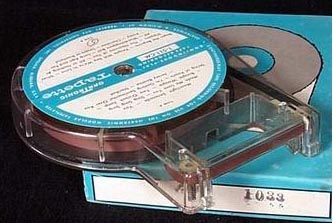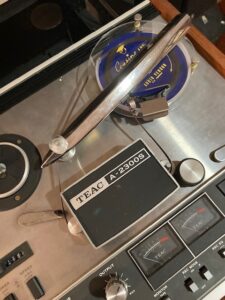
A Cousino Electronics Audio Vendor mounted on an open-reel recorder
Meanwhile, a number of new contenders rose up to enjoy fleeting moments of success selling endless-loop tape systems for personal or home entertainment. Bernard Cousino of Toledo, Ohio’s Cousino Electronics, for example, had designed an endless-loop tape device, playable on open-reel recorders, that he marketed as a point-of-sale advertising system. He later developed an endless-loop cartridge that he called the Echo-matic. He had a measure of success with his Echo-matic in the early 1960s, also as a “point of sale” advertising medium or background music technology. Some were adapted for other purposes such as providing the soundtrack for photographic slide presentations, and there is a connection between the Echo-Matic and the later Fidelipac endless loop system that was used in broadcasting from the 1950s through at least 2000. In 1965, the Champion Spark Plug company (a subsidiary of Ford) purchased a controlling interest in Cousino’s firm. The timeline is unclear, but it seems likely that with the success of the 8-Track, Champion and/or Ford wanted to sell a competitor to the 8-track.
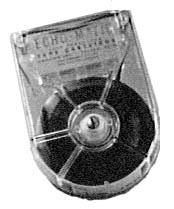
A Cousino Electronics Echo-Matic cartridge
Cousino was involved in another significant tape venture as well. In the the early 1960s he had become acquainted with Alabama businessman John Herbert Orr, founder of Orradio Industries, a recording tape manufacturing firm that had recently been acquired by Ampex Corporation. Orr was looking for new opportunities, and with Cousino he created a new firm, called Orrtronics, to manufacturer a home / automobile tape entertainment system based on the Cousino Echo-matic cartridge. The resulting Orrtronics Auto-Mate players and their “Tapette” cartridges (shown at the top of this page) sold in relatively small numbers for a few years in the mid-1960s. Regular Echo-matic systems seem to have persisted into the 1970s.
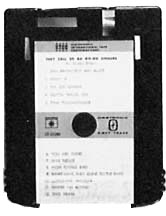
Orrtronics 8 track cartridge. The novel placement of the tape-head opening is seen at the top left.
Meanwhile, Ford was evidently debating whether it would adopt the Learjet Stereo 8 system in 1965, and was looking to its Champion division for guidance. In the short period in 1965 before it became clear that the 8-track would be widely adopted throughout the auto industry, Champion considered introducing a competing product that did not infringe on Learjet’s patents. Again, source documents are incomplete, but Champion apparently funded the development at Orrtronics of a competitor to the 8 track. The “Orrtronics 8-Track” was cartridge similar to the Learjet product except for the dimensions of the plastic housing and the way the tape loop was routed inside it. In the Orrtronics version, the playback head contacted the tape vertically through an opening in the cartridge rather than horizontally as in the Learjet system. It’s not clear whether the Orrtronics 8-track was ever sold to the public.
The alternative to the 8-track that saw the most significant commercial success was a very different type of product than these others. The Playtape system was a portable tape player using a small, two-track, endless loop cartridge with a tape that was just a few millimeters wide. Playtape was apparently introduced in the fall of 1966, and appears to have been based on an existed set of patented designs. In slightly modified form, the same cartridge was the medium in Dictaphone branded telephone answering machines in the 1970s. Playtape was marketed to the “teeny bopper” demographic – the company made no claims about high fidelity, but the system did offer inexpensive players and tapes, portability, and a catalog of recordings. The tapes were for the most part multi-song selections by single artists, featuring top-40 pop, songs from movie soundtracks, and other light entertainment.
Playtape cartridges, pictured below, measure about 4 inches on the long dimension, and came in mono and stereo versions.
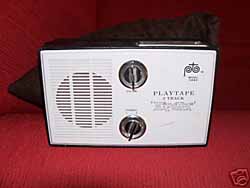
Playtape

Playtape cartidges
